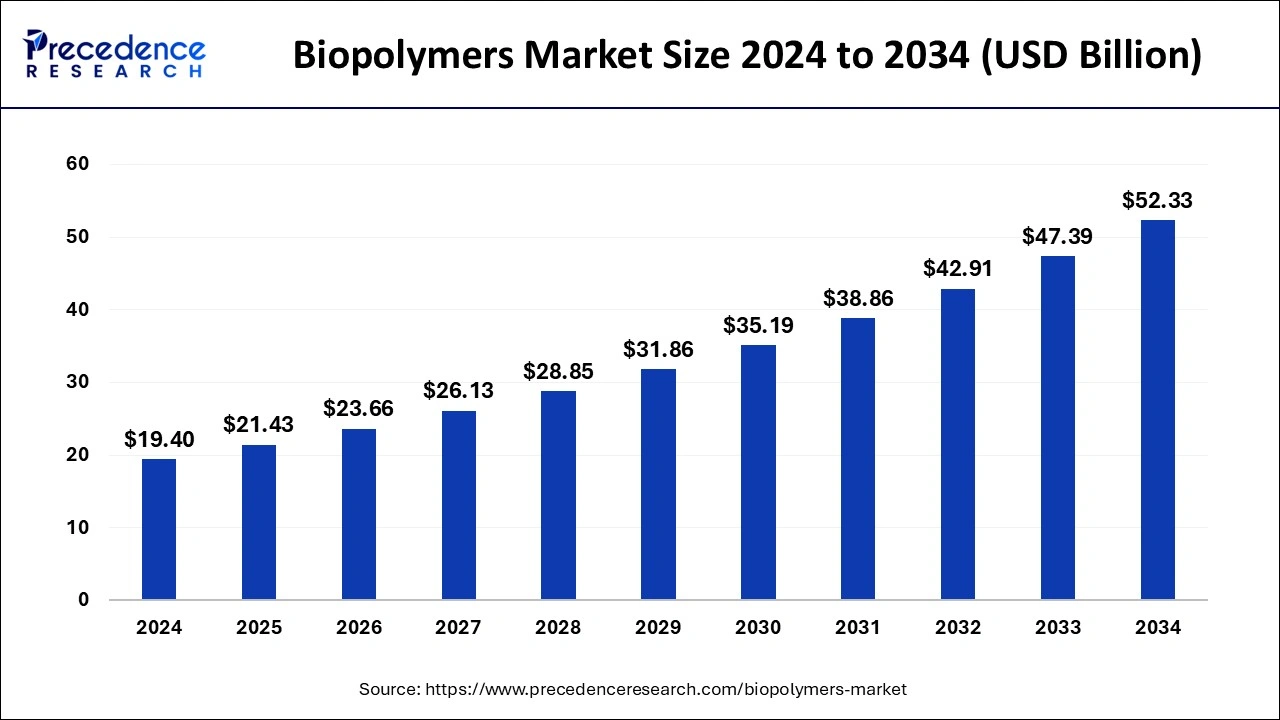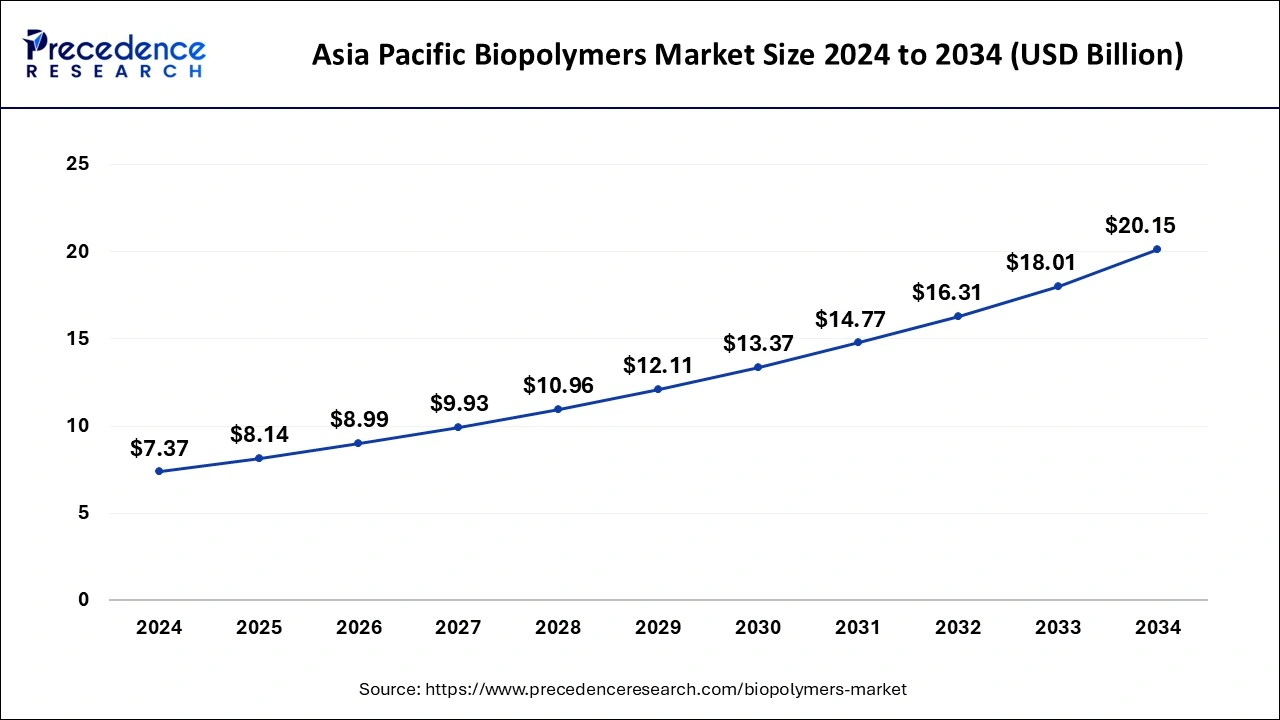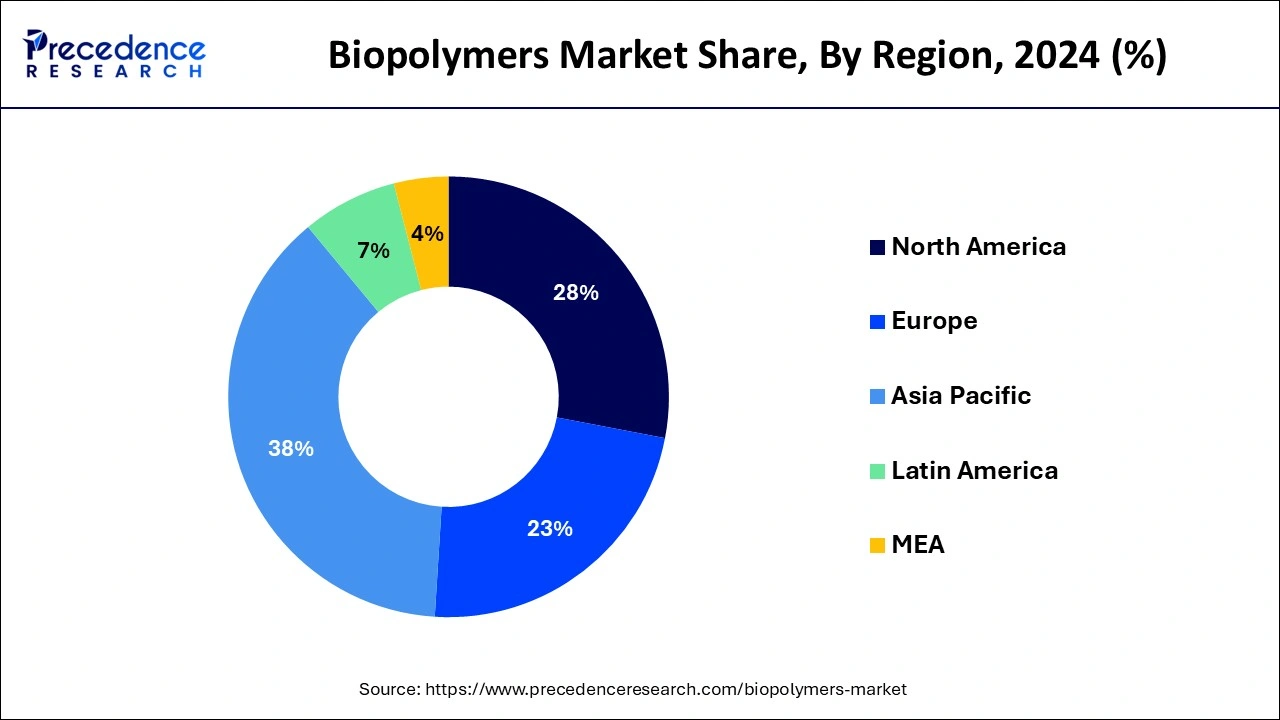The global biopolymers market size is calculated at USD 21.43 billion in 2025 and is forecasted to reach around USD 52.33 billion by 2034, accelerating at a CAGR of 10.43% from 2025 to 2034. The Asia Pacific biopolymers market size surpassed USD 7.37 billion in 2024 and is expanding at a CAGR of 10.58% during the forecast period. The market sizing and forecasts are revenue-based (USD Million/Billion), with 2024 as the base year.
The global biopolymers market size was accounted for USD 19.4 billion in 2024 and is expected to exceed around USD 52.33 billion by 2034, growing at a CAGR of 10.43% from 2025 to 2034. Consumer demand, regulatory pressure, biotechnology innovations, applications in food, healthcare, and nutricosmetics, and the waste management benefits from agricultural waste drive the biopolymers market.

Artificial intelligence revolutionizes biopolymer manufacturing through its processing, waste minimization, and production of higher-quality products. Machine learning and machine vision are used to analyze historical and real-time data, which can pre-empt possible issues with defects and wastage. Thus, AI automates nearly all quality control operations, leading to more accurate results. All of these translate to significant potential benefits from the integration of AI into polymer manufacturing, such as improved process efficiency, enhanced product quality, reduced maintenance costs, and better optimization of the supply chain. Most applications of AI relate to process optimization combined with quality control and supply chain management, providing important practical applications in these fields. The applications of digital transformation in the plastics industry will continue to highlight the invaluable role of AI.
The Asia Pacific biopolymers market size was evaluated at USD 7.37 billion in 2024 and is predicted to be worth around USD 20.15 billion by 2034, rising at a CAGR of 10.58% from 2025 to 2034.

Asia Pacific dominated the biopolymers market in 2024 by capturing the largest share. Increased environmental concerns and heightened demand for sustainable materials are major factors contributed to region’s dominance. Governments in Asian countries have also imposed stringent regulations to reduce plastic packaging waste and promote the use of bioplastic. In addition, the rapid expansion of the packaging industry and the increased demand for biopolymers in various industries bolstered the growth of the market in the region.

The market in Europe is anticipated to expand at the fastest growth during the forecast period. This is mainly due to the rising usage of bio-based products, including bioplastics. There is a strong focus on sustainability in European countries. The European Union has imposed stringent regulations on plastic use, encouraging industries to adopt bioplastics. Moreover, rising awareness of environmental sustainability is boosting the adoption of bio-based products, contributing to regional market growth.
Flexible plastic produced using synthetic mixtures got from or incorporated by microorganisms like microbes or hereditarily adjusted plants. Bioplastics are thermoplastics produced using bio-based materials like sugar, kelp, and starch. Biopolymers are a general class of materials that incorporates bioplastics as well as regular polymers like silk, chitosan, and fleece. Starch, alginate and cellulose are instances of polysaccharides, which are straight or stretched polymeric sugars. Regular rubbers, suberin and lignin, cutin and cutan, and melanin are instances of biopolymers. Human and creature squander, plant items, and agrarian waste are utilized to make bio-plastics, which are then reused and transformed into new items utilizing state of the art innovation.
Biopolymers are produced using waste starch, biomass and other sustainable feed stock. There are a few economically accessible polymers, (for example, polylactic corrosive, bio-nano composites and poly-hydroxy-alkanoate, and so on) which are utilized in the hardware and car businesses.
Legislatures are empowering the utilization of biodegradable polymers over ordinary polymers to diminish carbon impression. A few significant auto organizations are presently choosing biopolymers in their vehicles; for example, the Ford Motor Company is involving biopolymers for inside applications.
| Report Coverage | Details |
| Market Size in 2025 | USD 21.43 Billion |
| Market Size by 2034 | USD 52.33 Billion |
| Market Growth Rate from 2025 to 2034 | CAGR of 10.43% |
| Base Year | 2024 |
| Forecast Period | 2025 to 2034 |
| Segments Covered | Type, Application, End User and Region |
| Regions Covered | North America, Europe, Asia-Pacific, Latin America and Middle East & Africa |
High possible in arising nations of APAC- The bioplastics and biopolymers market players are persistently executing natural and inorganic methodologies for their development. Lately, the players have made numerous essential advancements in the arising nations of APAC. For example, in 2019, Total Corbion set up a PLA Plant in Rayong, Thailand, with a creation limit of 75,000 tons each year. Moreover, Indonesia is investigating bioplastic choices, like kelp. Evoware, a neighborhood player, gives licensed ocean growth based packaging. The organization is delivering compartments produced using ocean growth. The guidelines connected with the climate are supposed to expand, which would ultimately push the interest for bioplastics in these nations later on. Also, Southeast Asia is rich in bio-based feedstock expected to deliver bioplastic as it has nearby admittance to sustainable natural substances. Consequently, guidelines, combined with the simple accessibility of feedstock, will, thusly, assist with supporting the interest for bioplastics during the estimate time frame.
Focal point of states on green acquirement arrangements and guidelines to expand the interest for bioplastics and biopolymers.
The developing need to decrease the reliance on regular petroleum derivatives is impelling the interest for bio-based items. This is likewise upheld by the new strategies and guidelines carried out and took on by the public authority bodies around the world. These guidelines incorporate prohibiting or executing extra additional charges on the utilization of regular plastics in applications, like shopping sacks, packaging materials, and disposables. These rising guidelines and denials against plastic packs and other plastic things are driving the market for bioplastics, particularly biodegradable plastics, around the world.
The packaging is projected to represent the biggest portion of the bioplastics and biopolymers market, by end-use industry, during the estimate time frame.
Packaging is the biggest end-use industry for the utilization of bioplastics and biopolymers. They represented the portion of 62%, in 2024, for the worldwide bioplastics and biopolymers market. Expanding ecological guidelines and changes in the way of life of buyers have expanded the interest for bioplastics and biopolymers in the packaging business. Plastics have high strength and impermeability to water, which has supported their utilization in packaging. Packaging utilizations of bioplastics and biopolymers incorporate food packaging, medical services packaging, corrective and individual consideration packaging, shopping sacks, and others.
The packaging business utilizes bioplastics and biopolymers. Therefore, bio-based unrefined components like starch and vegetable waste yield side-effects, are being utilized to agree with rigid government natural guidelines. Thus, item quality is lower in this industry than in customary plastic item producing enterprises.
Food and refreshment packaging, drug packaging, and convey sacks are conceivable packaging portions for bioplastics and biopolymers. Organizations in the PLA business utilize recyclable items, which help to drive the market. The interest for PLA-based polymers is being driven by the developing interest for harmless to the ecosystem packaging produced using bio-based polymers.
By Type
By Application
By End User
By Geography
For inquiries regarding discounts, bulk purchases, or customization requests, please contact us at sales@precedenceresearch.com
No cookie-cutter, only authentic analysis – take the 1st step to become a Precedence Research client